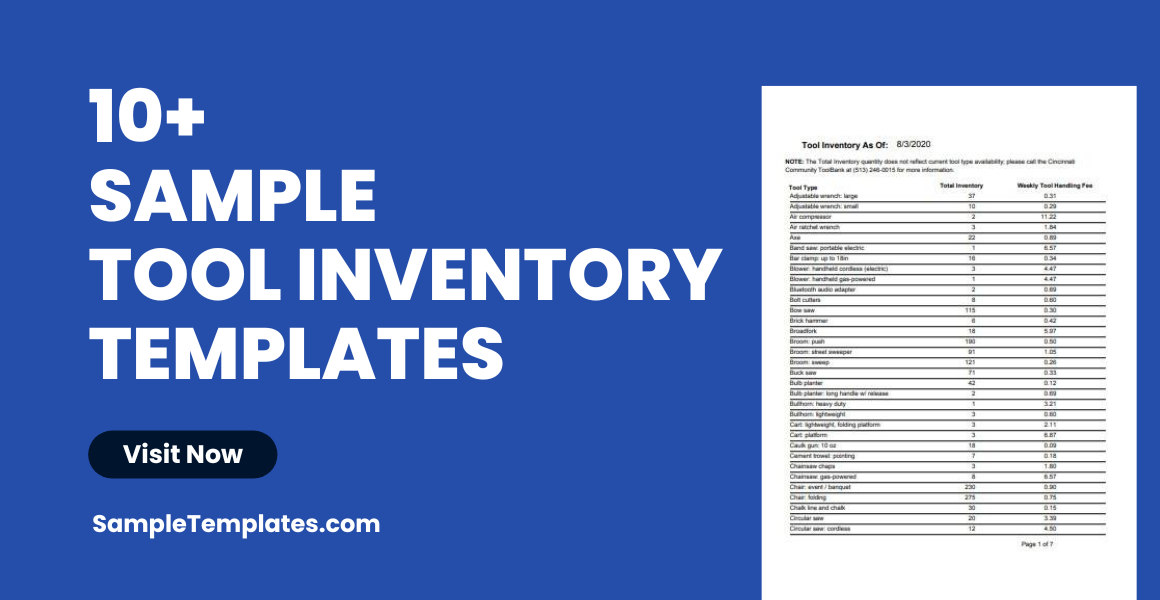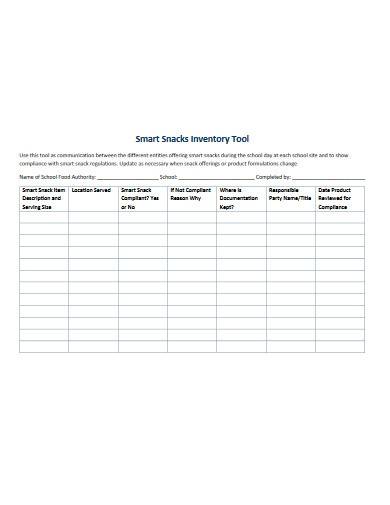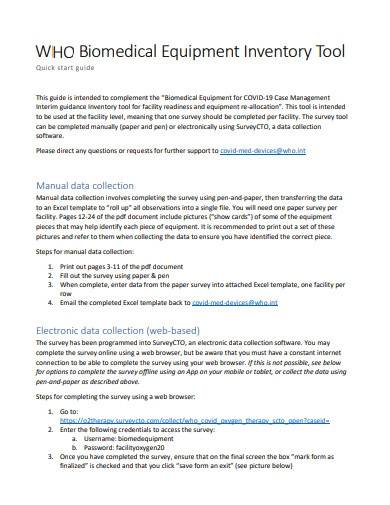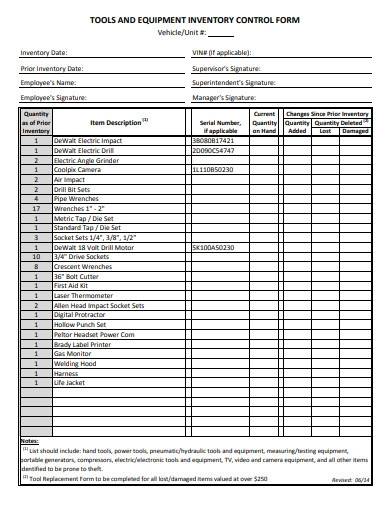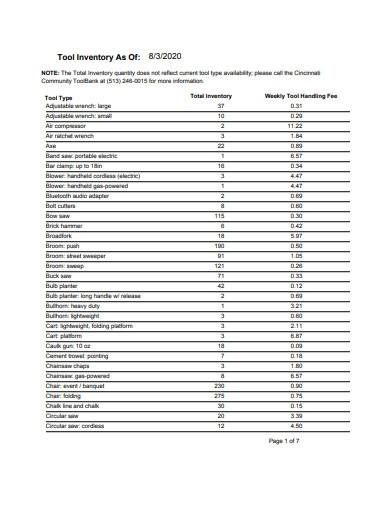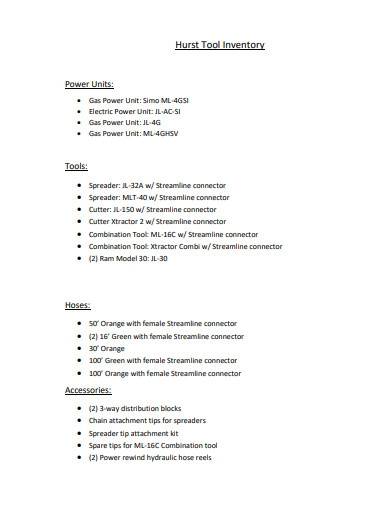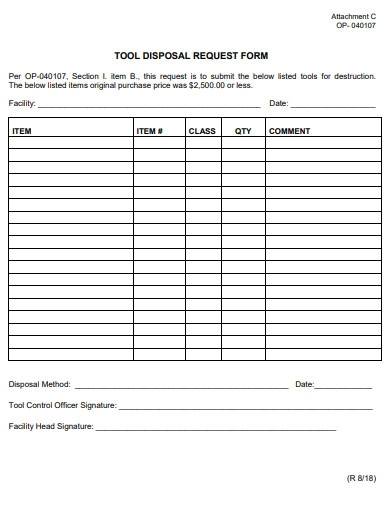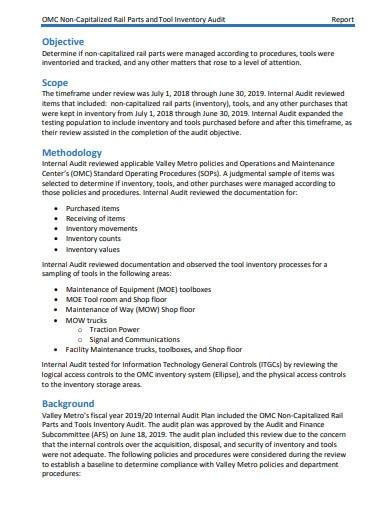Having the stock knowledge of the inventory and location of tools and equipment for your personal life or business work is very helpful and it serves a good purpose in evaluating the items and products. For example, a blacksmith possesses a dynamic ability in knowing about the tools and their arrangements. The stock of knowledge represents knowledge at a moment in time, but it is the open quality and potential for reorganization of the information. Thus, there is a manifestation of underlying knowledge to the significance of the arrangement of inventory tools. In this article, we provide you some informative guide in creating a tool inventory and choose from our collection of templates that you can use.
FREE 10+ Tool Inventory Samples
1. Tool Inventory Template
2. Biomedical Equipment Inventory Tool
3. Tools and Equipment Inventory Control Form
4. Tool Inventory Sheet Template
5. Tool Inventory Management
6. Sample Tool Inventory Template
7. Sample Hurst Tool Inventory
8. Tool Inventory Form Template
9. Financial Reporting Tool Inventory
10. Sample Tool Inventory Audit
11. Inventory Tool Management Worksheet
What is a Tool Inventory?
A structured inventory system has the ability to collect a variety of information from a variety of different sources. Carefully controlling the tool inventory is the process of managing supplies efficiently, knowing what supplies are on hand and where they are located. So, building an inventory of necessary materials is essential in maintaining accountability by recording of what items were purchased, how many are in stock, etc.
The essential parts of inventory management are conclusion planning, organizing, directing, and controlling activities. You or the person who will be in-charge in managing your tool inventory should have these skills and characteristics: systematic task organization, time management, attentiveness, mindfulness, and resourcefulness.
How to Create a Tool Inventory
Creating an inventory list of your tools, items, and other belongings is an important part of minimizing clutter in your area and storing up your personal and business resources. Preparing a tool inventory list is a simple way that can help you stay organized, save money and protect you in the event of a disaster or theft requiring an insurance claim. So, here are the useful tips and guides to assist you in creating this list:
1. Organizing your tools
Have you experienced losing a screwdriver for numerous times and then buying the exact same item again and again? To prevent this repeated cycle of losing and buying items, organizing your tools is really helpful in keeping track of them.
Finding and designating a place for all of your tools is a basic step to creating a tool inventory. Organizing your office, garage or basement workshop or tool shed is also a significant safety factor that can lessen the possibility of injury.
The book “How to Organize (Just About) Everything” recommends you to add and delete from the inventory catalog and storage logs as you obtain new items and rotate or eliminate existing ones.
2. Classifying your items and products
For the purpose of identification and inventory, it is mandatory to classify or categorize all the tools, mark each with a distinguishing symbol, use your preferred color-coding system, label them and then find them a rightful space. Linda Koopersmith, the author of the book “Beverly Hills Organizer’s Home Organizing Bible” wrote that labels are a crucial part of organization. She added that a clear plastic container without a label resembles a cake without icing.
Moreover, make sure that you carefully arrange the tools and gather tools with similar usage, specified for a task. For instance, place the rollers and brushes with painting tools when you are working in a product design workshop or construction site. If you’re working in a pastry shop or cafe, place the measuring cups, spatulas, and whisks with baking tools.
3. Write down a list of your inventory
One thing that an organized person never forgets and always does is having a notebook or journal traditionally or digitally. This is an effective instrument in writing down the tool, and categorizing it. Plus, you can take a picture on your phone and attach it to your list. A simple handwritten or or typewritten list or an online spreadsheet will work fine.
If you’re doing the traditional way, keep a copy of the handwritten tool inventory nearby. Keeping it consistently visible with your tools will remind you to update it as you add tools to your collection. Also, snap a picture of the inventory every time you update it so you always have a copy.
For a quick, no-fuss record of your tool inventory, use a sample note-taking app that also has photo-attachment features like Evernote. Going digital is a very economical way to monitor your inventory while cutting down the use of papers and most importantly, preserving and sustaining our environment.
4. Verify the value of your tools
Make a thorough calculation and estimation of your tools’ value. Include this in your list of tool inventory. If for some reason your tools and/or storage is destroyed or your tools are stolen, they are covered. However, this is only possible if you have detailed tool inventory.
FAQ
The inventory control tools are barcode data collection, timely and accurate reporting, cycle counting, ABC analysis, integrated sample planning and execution, and lot tracking and traceability.What are the tools of inventory control?
An article explains that having a smart management of tool inventory allows you to collect useful data analysis concerning utilization and assists you in determining hindrances. In this way, you are able to streamline workflows. Also, the use of check-in and check-out features will definitely help workers reserve the equipment that they need in the future, avoiding the struggle in searching for the assets.Why do we need to have an inventory of tools?
Based on this article, in managing your tools, you need to create an inventory, and write down a list of all existing tools. Then, insert make, model, and manufacturer information in the inventory list. Also, record the quantity if there is more than one of the tools or part. Lastly, assign each tool a unique identification number.How do you manage tooling inventory?
According to this article analysis, create an inventory list of all existing tools. Include make, model, and manufacturer information in the inventory list. Also record the quantity if there is more than one of the tools or parts. Assign each tool a unique identification number.How do you manage tooling inventory?
An inventory of tools and their locations relative to one another yields a large set of open possibilities. No matter what choices you make in downsizing the amount of clutter you currently have in your storage, garage, or tool corner, it is all part of the organizing process. Perhaps starting to organize your tools is a stressful thing to you. Don’t worry because it’s normal. Remember to stay with the plan you set for the space will certainly help you on track. So, to help you in this matter, check out our sample inventory sheets. We hope that this article will help you in organizing your tools.
Related Posts
FREE 12+ Sample Inventory Sheet Templates in Google Docs ...
FREE 17+ Sample Handover Reports in PDF MS Word | Google Docs
FREE 10+ Needs Assessment Samples in PDF MS Word
FREE 5+ Retail Audit Checklist Samples in PDF Excel
FREE 13+ Equipment Inventory Templates in PDF MS Word | Excel
FREE 12+ Control Checklist Samples & Templates in PDF MS ...
FREE 10+ Retail Form Samples in PDF MS Word
FREE 6+ Inventory Risk Management Samples in PDF DOC
FREE 11+ Asset Mapping Samples & Templates in PDF Ms Word
FREE 8+ Career Assessment Samples in MS Word PDF
FREE 25+ Sample Restaurant Checklist Templates in Excel PDF ...
FREE 7+ Sample Medical Assistant Job Dutie Templates in MS ...
FREE 8+ Recording Transaction Samples in PDF MS Word | Excel
FREE 9+ Sample Product Pricing Calculator Templates in PDF
FREE 10+ Project Operational Plan Samples in PDF MS Word
